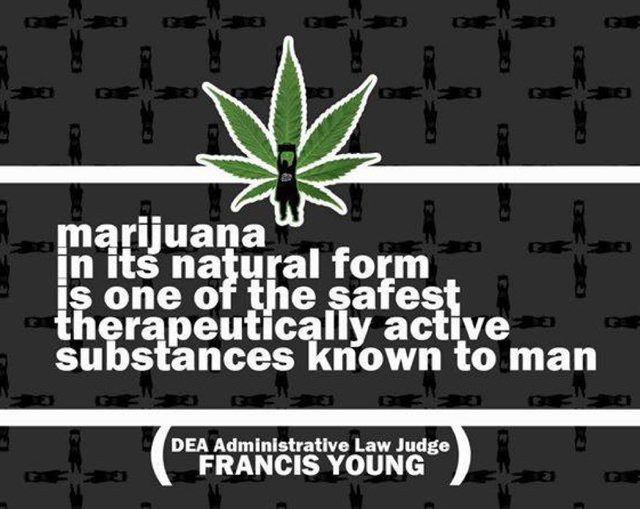The DEA Judge Who Tried to Change It All
Cannabis legalization has had a turbulent history. From being used medicinally for millennia, it went on to become a demonized and prohibited compound. As it now stands, cannabis is one of few natural compounds which remains listed as a Schedule I substance by the United States’ Drug Enforcement Administration (DEA), which goes about enforcing the Controlled Substance Act (CSA).
Schedule I is the most prohibitive category in which a compound can be placed. In order to be considered for Schedule I, a compound must1:
(A) Have a high potential for abuse:
(B) Have no currently accepted medical use in treatment in the United States, AND:
(C) Have a lack of accepted safety for use under medical supervision.
These restrictions also apply to immediate chemical or biochemical precursors.
It’s important to note that “a drug or other substance may not be placed in any schedule unless the findings required for such schedule are made with respect to such drug or other substance.”1 The way the section is written implies the burden of proof is on the Department of Justice, which oversees the DEA, to provide the findings in support of the classification in each schedule.
Since the inception of the schedule system in 1970, the classification of cannabis (and now tetrahydrocannabinol as well as cannabis extracts) under Schedule I has been contested on every ground. In 1972, the National Organization for the Reform of Marijuana Laws (NORML) petitioned the Bureau of Narcotics and Dangerous Drugs (now the DEA) to reschedule cannabis to Schedule II on the grounds that cannabis did not satisfy sections (B) and (C) of the Schedule I requirements: i.e., that cannabis possessed currently accepted medical use and was accepted as safe for treatment under medical supervision. In 1995, Jon Gettman and High Times magazine filed another rescheduling petition, this time on the grounds that cannabis did not satisfy section (A): i.e. did not have a high potential of abuse. The result of both petitions was a Final Notice by the sitting Administrator of the DEA ruling to deny the motion to reclassify.
Both petitions tested the boundaries of the CSA, and led to the creation of legal precedents which continue to influence decisions regarding cannabis legislation to this day. But the NORML petition contained one odd perpendicularity: It was initially supported by the sitting judge of the DEA itself.
In 1986, DEA Administrator John C. Lawn initiated a period of public hearings on the merits of reclassifying cannabis. As Chief Administrative Judge of the DEA, it was the responsibility of Judge Francis L. Young to supervise the hearings, analyze their content, apply them to case law the law saw fit, and make a recommendation to the Administrator. After two years and thousands of pages of documents, Judge Young issued an entirely surprising verdict: “The overwhelming preponderance of the evidence in this recordestablishes that marijuana has a currently accepted medical use intreatment in the United States… To conclude otherwise,on this record, would be unreasonable, arbitrary and capricious.”3
Judge Young interpreted that the DEA, in asking the question, ‘Should the drug be accepted for medical use?’ was side-stepping the petitions’ determining question, ‘Has the drug been accepted medical use?’ [emphasis added]. He concludes that the agency has addressed the wrong question, and in doing so, “[the] DEA is actually making the decisionthat doctors have to make, rather than trying to ascertain the decision which doctors have made. Consciously or not, the Agency is undertakingto tell doctors what they should or should not accept.” The CSA only grants the DEA authority to make the determination whether a compound does or does not have accepted medical use, he argues, not whether or not the compound should.
The DEA relies on criteria provided by the Food and Drug Administration (FDA) to determine the findings required for scheduling. It equates ‘accepted medical use’ with receiving FDA approval for lawful marketing. But whether there is sufficient clinical evidence for a drug to be given FDA approval remains immaterial to the consideration of whether it has accepted medical use. Judge Young further explains that together with the fact that the substance in question is not a drug, but a natural plant, “it is unreasonable to make FDA-typecriteria determinative of the issue in this case.” He is equally assertive that the acceptance by a “significant minority of doctors” of cannabis as safe to prescribe under medical supervision is enough for it to no longer satisfy the requirements of section (C).
Clearly this recommendation was not implemented. Sitting DEA Administrator Lawn, who ironically opened the public hearings on the matter himself, was outraged by the findings. “These are not the Dark Ages,” Lawn wrote4. He lambasts the recommendation of Judge Young as having “attempted to perpetrate adangerous and cruel hoax on theAmerican public,” and “stronglyurges the American public not to
experiment with a potentially dangerous, mind-altering drug.” Now, 40 years later, cannabis remains a Schedule I drug.
Judge Young concludes his recommendation with the resounding words, “The judgerecommends that the Administrator transfer marijuana from Schedule I toSchedule II.” Will it take another 40 years until these words echo true?
References
- 21 U.S.C. §812(b)(1)
- 21 U.S.C. §812(b)
- Young, Francis L. (September 6, 1988). “In The Matter Of MARIJUANA RESCHEDULING PETITION, Docket No. 86-22: OPINION AND RECOMMENDED RULING, FINDINGS OF FACT, CONCLUSIONS OF LAW AND DECISION OF ADMINISTRATIVE LAW JUDGE“. Schaffer Library of Drug Policy. Retrieved 2018-07-04.
- 54 Fed. Reg. 53493










